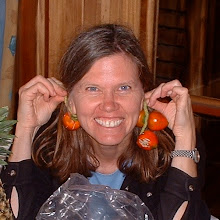As we approach the beginning of the rainy season, many birds in the Monteverde area are starting their nesting. Finding good real estate is not easy in Monteverde, even for birds. Cavity dwelling birds need a large tree with a rotten center that they can excavate. We recently saw this Resplendent Quetzal working on this nest hole.
Here's a picture taken a few years ago of a Quetzal emerging from his nest hole.
Both parents of this species work on the nest, incubate the eggs and feed the chicks. The Monteverde Cloud Forest Reserve and others provide artificial nest boxes that are sometimes used by Quetzals. The nest boxes are filled with wood chips so the birds can "excavate" them.
In San Luis we recently saw a female Masked Tityra working on a nest in a dead snag as the male perched nearby.
For the last several years we've seen several species nesting or attempting to nest in the same trunk. The top of this tree broke off this season and its potential as a nest site must be almost over as it continues to rot away.
Of course most birds don't want their nest location known and the cunning little nests of hummingbirds are particularly hard to find. Besides being small they look like a little ball of moss, just another of many epiphytes growing on most cloud forest trees and plants. By the way, any hummingbird sitting on a nest is a female as the males don't contribute anything to the nesting effort. This is a female Purple-throated Mountain Gem.
Other birds also camouflage their nests, such as this Slaty-backed Nightengale Thrush, a cloud forest bird that is difficult to see but whose beautiful song is frequently heard.
Birds generally will sit very tight on their nest without moving in the hopes of not revealing their location. Too much disturbance by curious people is very stressful for birds and could result in them abandoning a nest. The photos in this post were taken through a telescope so as to not disturb the birds.
Even the ubiquitous Clay-colored Robin has a beautifully hidden nest.
Finding nests is a challenge—Mr. Rududu is very pleased if he gets a few good nest photos in a year.
Here's a picture taken a few years ago of a Quetzal emerging from his nest hole.
Both parents of this species work on the nest, incubate the eggs and feed the chicks. The Monteverde Cloud Forest Reserve and others provide artificial nest boxes that are sometimes used by Quetzals. The nest boxes are filled with wood chips so the birds can "excavate" them.
In San Luis we recently saw a female Masked Tityra working on a nest in a dead snag as the male perched nearby.
For the last several years we've seen several species nesting or attempting to nest in the same trunk. The top of this tree broke off this season and its potential as a nest site must be almost over as it continues to rot away.
Of course most birds don't want their nest location known and the cunning little nests of hummingbirds are particularly hard to find. Besides being small they look like a little ball of moss, just another of many epiphytes growing on most cloud forest trees and plants. By the way, any hummingbird sitting on a nest is a female as the males don't contribute anything to the nesting effort. This is a female Purple-throated Mountain Gem.
Other birds also camouflage their nests, such as this Slaty-backed Nightengale Thrush, a cloud forest bird that is difficult to see but whose beautiful song is frequently heard.
Birds generally will sit very tight on their nest without moving in the hopes of not revealing their location. Too much disturbance by curious people is very stressful for birds and could result in them abandoning a nest. The photos in this post were taken through a telescope so as to not disturb the birds.
Even the ubiquitous Clay-colored Robin has a beautifully hidden nest.
Finding nests is a challenge—Mr. Rududu is very pleased if he gets a few good nest photos in a year.












3 comments:
Hello Carolina! Such glorious cavity dwellers you have. Here in Virginia we have Eastern Blue Birds nesting in the box in our yard (our trees not being cavernous enough), house wrens and tree swallows. April is absolutely raucous with birds.
I love the star ball that you are working on! What got you started on those?
Abrazos,
Karen (of Annie and Rick, por supuesto)
Hi Karen! Spring is such an exciting time. I think the last Baltimore Orioles of the year left here this past week to head north. Maybe we'll see some in Madison that fattened up on our banana feeder here.
I got started on temari because I had some I bought and just really wanted to give it a try. It turned out to be much easier than I expected! I love playing with colors that I don't necessarily want to wear, so it's different than knitting. And faster.
Hello!
I have a video I took of a nest in the cloud forest of Costa Rica which I have been trying to identify. I tried looking up photos but nothing quite fits, it was only a couple feet off of the ground, it was neatly bound and had moss. I looked at the Nightingale Thrush, Rufous Hummingbird and Magenta-throated Woodstar but they might be too small. Do you have Instagram, would you look at the video?
My account is navigatingserenity
(Look at the cloud forest video and the nest is in that post.)
Post a Comment